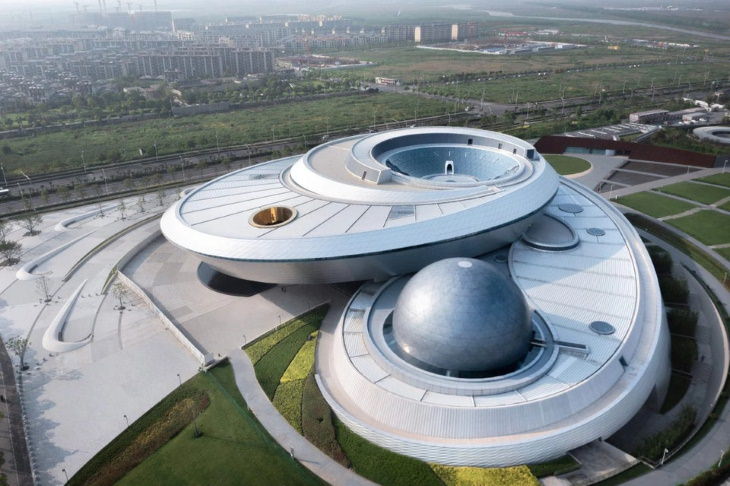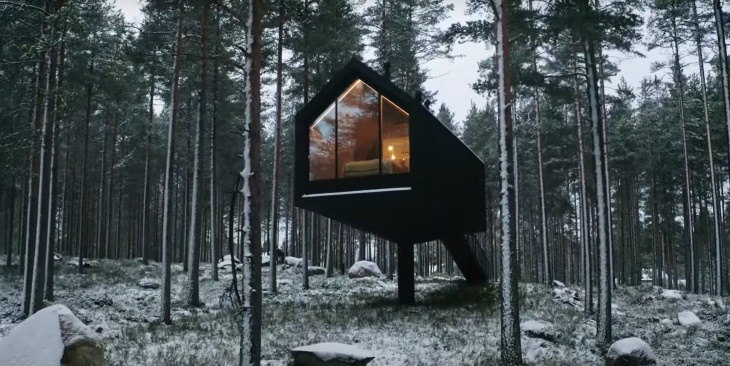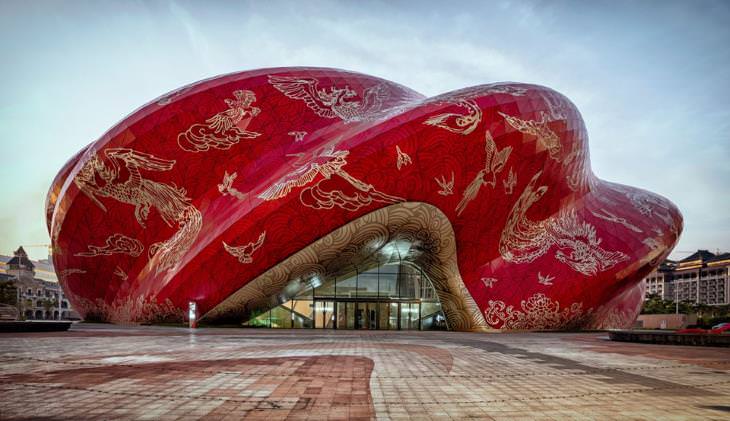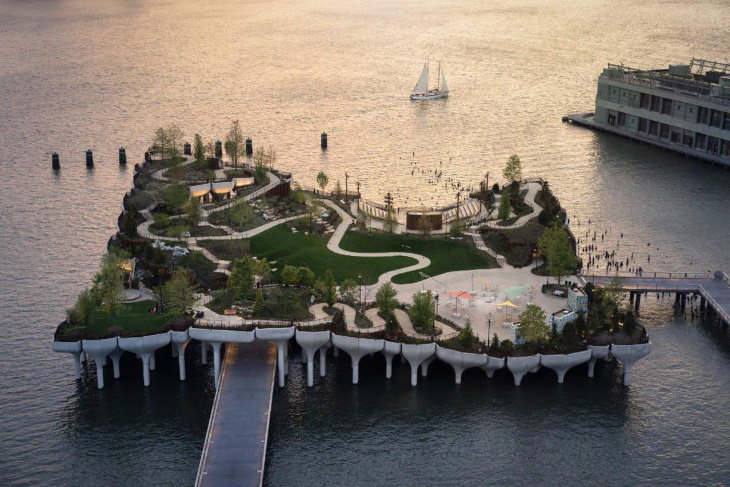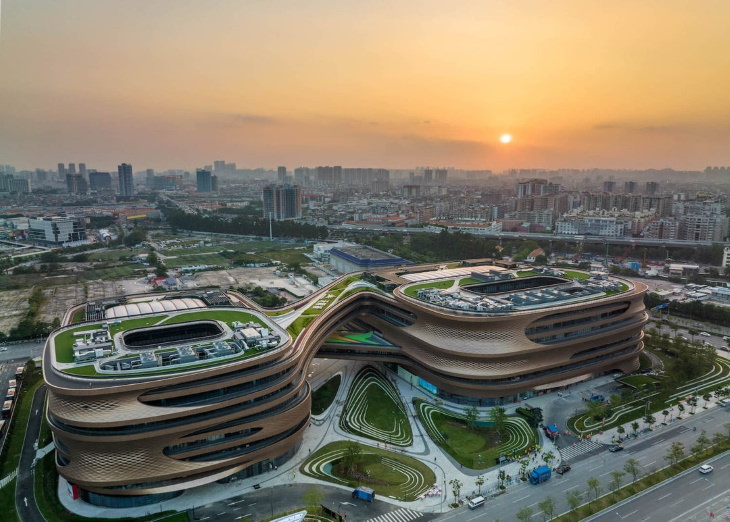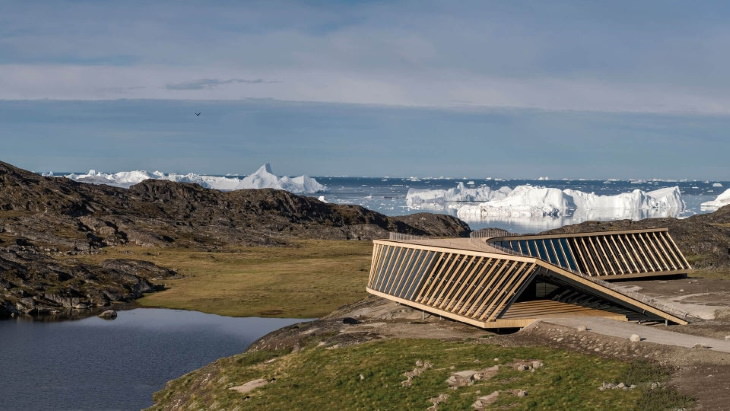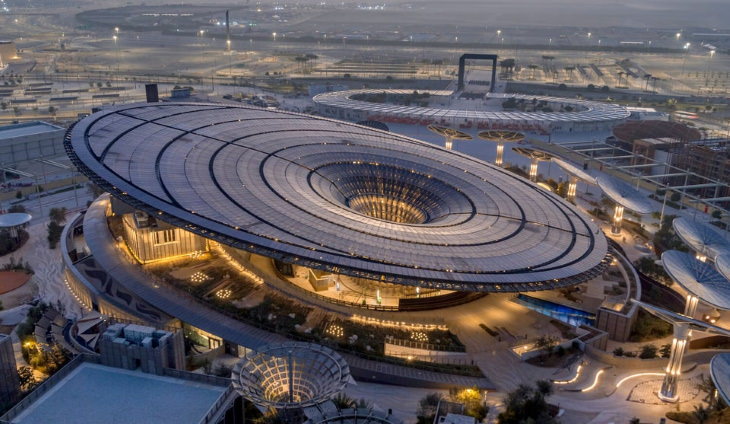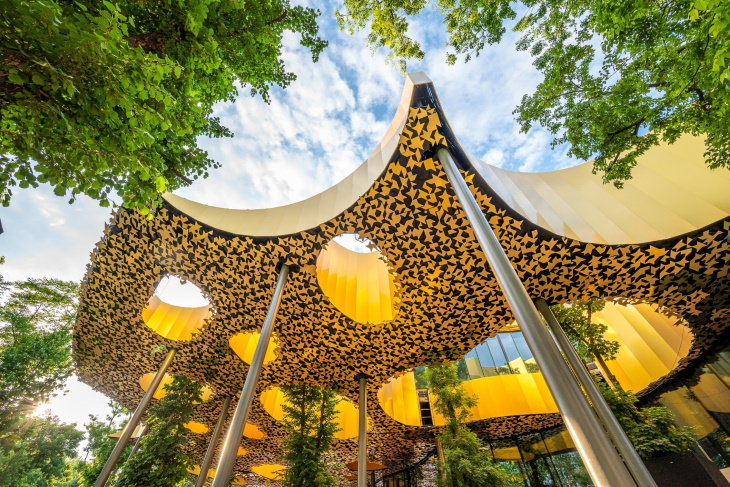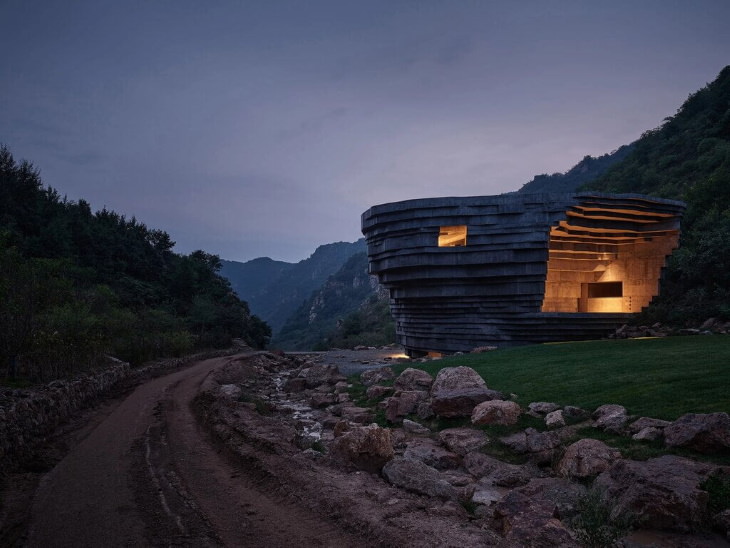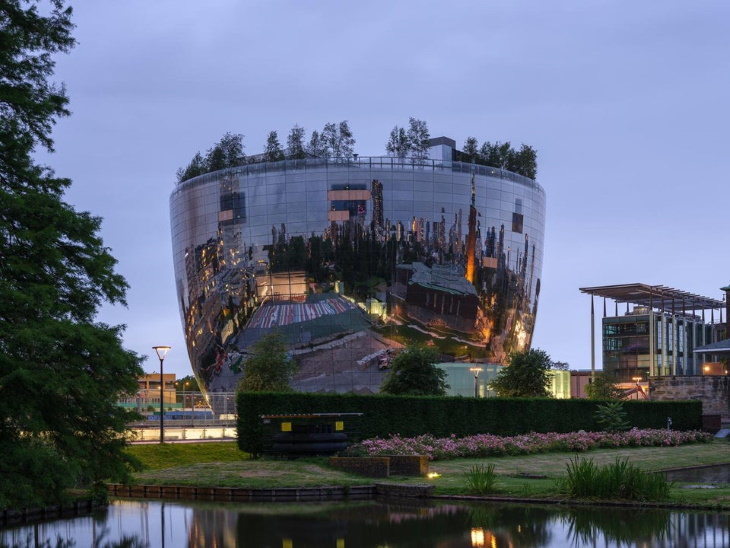1. Shanghai Astronomy Museum by Ennead Architects - Shanghai, China
The brand new Shanghai Museum of Astronomy opened to the public on July 18, 2021, becoming the world’s largest astronomical museum and planetarium. The building was designed by Thomas J. Wong, and it is meant to replicate the orbital relationship between planetary bodies.
The rounded shapes are reminiscent of planetary orbits, and the dome at the center is like a planet. These subtle but effective references introduce visitors to the cosmos and astronomy even before they set foot inside the building. In addition to many astronomical exhibitions, the museum also has an observatory, a Digital Sky Theater, and a 78-foot (24 m) tall solar telescope.
2. Niliaitta Cabin by Studio Puisto - Finland
Standing on one “leg” in the middle of the woods next to the Salamajarvi National Park in Finland, the Niliaitta cabin makes a lasting impression on anyone who has ever seen it. The pitch-black wooden home with a floor-to-ceiling window may not be a massive architectural project, but its unique design is definitely worth a special mention.
Designed by Studio Puisto, this elevated cabin is inspired by ancient building structures called Niliaitta, invented by the indigenous Sami people from Lapland as a way to store food outside. The modern Niliaitta aims to pay tribute to the Sami culture and create a remote and sheltered environment for visitors.
3. Sunac Guangzhou Grand Theatre by Steven Chilton Architects - Guangzhou, China
Definitely the boldest building on this list, the Sunac Guangzhou Grand Theatre marries tradition and contemporary architecture like few projects do. The architects aimed to preserve Guangzhou’s history as the heart of the Silk Road, hence the bold red color and fluid shape of the building that are meant to imitate the folds of silk.
The colorful cladding of the building features illustrations developed by the contemporary Chinese artist Zhang Hongfei. The Sunac Guangzhou Grand Theatre is a public theater that hosts local performances and other entertainment venues.
4. Little Island by Heatherwick Studio and MNLA - New York City, USA
New Yorkers now have a new nature retreat in the middle of the Hudson River. You read that right - in the river! The 2.4-acre (0.97 ha) manmade island is located west of Manhattan and is adjacent to Hudson River Park. The Little Island park is supported by 132 columns that act as garden pots. They're called tulip pots, and they hold the dirt and plant life that make up the park. These tulip pots are elevated at different levels to prevent flooding and provide a beautiful view of the city from the top.
There are several trails and an amphitheater at the Little Island, which has been open to the public since May of 2021.
5. Infinitus Plaza by Zaha Hadid Architects - Guangzhou, China
The futuristic Infinitus Plaza is certainly one of the coolest office buildings in existence. Designed by Zaha Hadid Architects, the Infinitus Plaza is part of the Baiyun Central Business district of Guangzhou. The building complex consists of two separate buildings, connected by bridges. They're designed as the headquarters of Infinitus China, a company that produces health products.
If viewed from overhead, the two interconnected buildings are meant to represent the infinity symbol - a subtle nod to the company name. Infinitus Plaza is covered by sheets of perforated aluminum, which play both an aesthetic and functionalist role, protecting the building from the elements. The headquarters have also been designed to recycle rainwater and harness solar energy.
6. Ilulissat Icefjord Centre by Dorte Mandrup - Greenland
To see the Ilulissat Icefjord Centre in person, you’d need to travel pretty far. The building is located in the coastal city of Ilulissat in Greenland 155 miles (250 km) north of the Arctic Circle. The Icefjord Centre is an educational center that explains the history of ice, local culture, and climate change through an audiovisual exhibition called The Tale of Ice. From the building’s roof, visitors can also admire the astonishing Kangia Icefjord.
As for the building itself, it is completely customized to the harsh environment. It consists of fifty steel structures that create a flat boomerang-shaped building. The positioning and shape of the building prevent the accumulation of snow and water on and under the building. All melted ice and snow flow directly into the nearby Sermermiut Lake. What an intelligent and informed design!
7. “Terra” The Sustainability Pavilion by Grimshaw Architects - Dubai, UAE
Dubai Expo 2020 is a world exposition that started on October 1, 2021, and will continue until March 31, 2022. The event was initially postponed due to COVID-19, but an array of magnificent pavilions are now open for the public. Terra is by far one of the most outstanding structures built for the Dubai Expo 2020. Part of the Sustainability district, the pavilion was designed by Grimshaw Architects.
Unlike many other temporary buildings, Terra is a permanent structure that hosts exhibitions about nature. It consists of a central pavilion called the “energy tree” and the surrounding smaller “trees” that rotate with the sun and help provide shade and generate energy and water. The main circular funnel structure is made of mostly recycled steel and is covered in solar panels. The Pavillion is fully sustainable, getting all of its electricity and water supply from the environment.
8. House of Hungarian Music by Sou Fujimoto - Budapest, Hungary
The new House of Hungarian Music is the center of the small European country’s music scene. Designed by the architect Sou Fujimoto, the project aims to provide space for the development of contemporary musicians, while also honoring Hungary’s historical contributions to music. The space incorporates concert halls, an open-air stage, and exhibition halls.
The defining feature of the structure is its punctured flat roof that has 100 holes of varying shapes and sizes. These holes are meant to invite plenty of natural light inside the building. The building is conveniently located in Budapest’s City Park, allowing easy access for visitors and locals alike.
9. Chapel of Sound by OPEN Architecture - Beijing, China
Without exaggeration, the Chapel of Sound is the most unique open-air concert hall you’ve ever seen! The Chapel of Sound is located deep in the mountains, a two-hour car trip from Beijing. From a distance, the monolithic structure looks just like a massive boulder that’s part of the mountainous landscape that surrounds it. Upon closer inspection, you notice a door. That door takes you to an amphitheater and another outdoor stage. There’s even a green room (a room for performers to relax before their show) built into the structure, as well as a viewing platform that offers a beautiful view of the ruins of the Great Wall of China.
The building has the shape of an inverted cone, which naturally creates great acoustics. OPEN Architecture designed the building out of concrete and rock, with the intention of helping visitors be immersed in the cradle of nature and experience music in a new way. Even when there are no concerts planned at the Chapel of Sound, visitors can come and enjoy a solitary time surrounded by the sound of nature.
10. Depot Boijmans Van Beuningen by MVRDV - Rotterdam, Netherlands
According to their official website, “Depot Boijmans Van Beuningen is the world’s first publicly accessible art storage facility.” The structure itself is shaped like a large reflective silver bowl and is located in Museumpark in Rotterdam, next to Museum Boijmans Van Beuningen. Inside the structure, a central hall is crisscrossed with a web of staircases that will take you to different levels of the Depot.
The art storage center encompasses 151,000 objects belonging to Museum Boijmans Van Beuningen. These objects are stored across 14 compartments in 5 varying controlled climate conditions. Apart from showcasing the massive art collection, the Depot allows visitors to observe art conservation and restoration.
Share these stunning buildings with those who love art!

